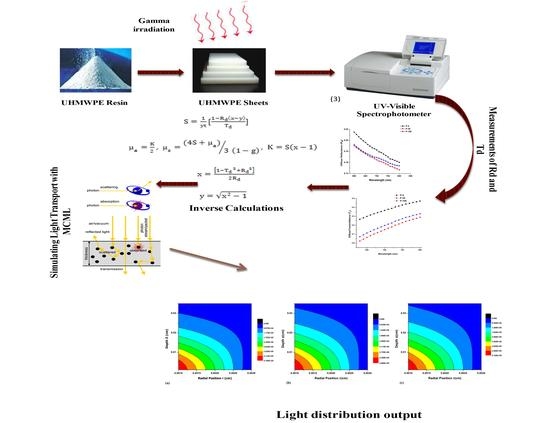Simulation of Light Distribution in Gamma Irradiated UHMWPE Using Monte Carlo Model for Light (MCML) Transport in Turbid Media: Analysis for Industrial Scale Biomaterial Modifications
Abstract
:1. Introduction
2. Materials and Methods
2.1. Material and Sample Preparation
2.2. Sample Irradiation
2.3. Measurements of Rd & Td
3. Results and Discussion
3.1. Effect of Radiation on Measurable
- Diffuse reflectance decreases as a function of incident wavelength for all samples, whether it is irradiated or un-irradiated.
- The amount of reflectance is higher in the visible range and lower in the near-infrared region.
- The amount of diffused reflected light is significantly reduced for 30 kGy and 100 kGy irradiated samples.
- Surface roughness of the sample
- Refractive index mismatch
- Sample thickness
3.2. Extraction of Optical Properties
- K is the flux loss per absorption per unit length
- S is the scattering per unit length
- Rd is the measured value of diffuse reflectance
- Td is the measured value of diffuse transmittance
- t is the sample thickness
3.3. Effect of Radiations on Extracted Optical Properties
- For an un-irradiated sample, μa increases from 5.34 cm−1 to 6.09 cm−1, and μs increases from 120.06 cm−1 to 128.02 cm−1 over the wavelength of interest, i.e., 630 nm to 800 nm. The higher the incident wavelength, the longer the mean free path is before each interaction, so the abovementioned increase in μa and μs (as a function of wavelength) for the pristine sample is quite understandable.
- There is a significant decrease in the coefficient (μa & μs) values from 630 nm to 700 nm for irradiated samples. Furthermore, it can be seen from the table that the decrease in coefficients for a 30 kGy irradiated sample is higher as compared to a 100 kGy irradiated one, which is due to greater oxidation damage [17,37,38,40] for the 30 kGy samples, as mentioned above.
- There is a slight increase in the values of μa on moving from 700 nm to 800 nm for irradiated samples, which is attributed to the dominant scattering and small absorption of polyethylene on near IR and IR absorption [27,30]. The decrease in per unit scattering length, i.e., μs from 700–800 nm and the significant increase in Td for irradiated samples (see Table 1 and Figure 2) also supports this argument.
3.4. Theoretical Validation of Extracted Optical Properties
3.5. Effect of Radiation on Light Distribution
4. Conclusions
Author Contributions
Funding
Institutional Review Board Statement
Informed Consent Statement
Data Availability Statement
Acknowledgments
Conflicts of Interest
References
- Barani, M.; Mukhtar, M.; Rahdar, A.; Sargazi, S.; Pandey, S.; Kang, M. Recent Advances in nanotechnology-based diagnosis and treatments of human osteosarcoma. Biosensors 2021, 11, 55. [Google Scholar] [CrossRef] [PubMed]
- Arshad, R.; Tabish, T.A.; Kiani, M.H.; Ibrahim, I.M.; Shahnaz, G.; Rahdar, A.; Kang, M.; Pandey, S. A hyaluronic acid functionalized self-nano-emulsifying drug delivery system (SNEDDS) for enhancement in ciprofloxacin targeted delivery against intracellular infection. Nanomaterials 2021, 11, 1086. [Google Scholar] [CrossRef] [PubMed]
- Sabir, F.; Zeeshan, M.; Laraib, U.; Barani, M.; Rahdar, A.; Cucchiarini, M.; Pandey, S. DNA based and stimuli-responsive smart nanocarrier for diagnosis and treatment of cancer: Applications and challenges. Cancers 2021, 13, 3396. [Google Scholar] [CrossRef] [PubMed]
- Calcagno, L.; Compagnini, G.; Foti, G. Structural modification of polymer films by ion irradiation. Nucl. Instrum. Methods Phys. Res. Sect. B Beam Interact. Mater. At. 1992, 65, 413–422. [Google Scholar] [CrossRef]
- Fink, D.; Chung, W.; Klett, R.; Schmoldt, A.; Cardoso, J.; Montiel, R.; Vazquez, M.H.; Wang, L.; Hosoi, F.; Omichi, H.; et al. Carbonaceous clusters in irradiated polymers as revealed by UV-Vis spectrometry. Radiat. Eff. Defects Solids 1995, 133, 193–208. [Google Scholar] [CrossRef]
- Mishra, R.; Tripathy, S.P.; Dwivedi, K.K.; Khathing, D.T.; Ghosh, S.; Müller, M.; Fink, D. Electron induced modification in poly (ethylene terephthalate). Radiat. Eff. Defects Solids 2001, 153, 257–269. [Google Scholar] [CrossRef] [Green Version]
- Mishra, R.; Tripathy, S.P.; Sinha, D.; Dwivedi, K.K.; Ghosh, S.; Khathing, D.T.; Müller, M.; Fink, D.; Chung, W.H. Optical and electrical properties of some electron and proton irradiated polymers. Nucl. Instrum. Methods Phys. Res. Sect. B Beam Interact. Mater. At. 2000, 168, 59–64. [Google Scholar] [CrossRef] [Green Version]
- Phukan, T.; Kanjilal, D.; Goswami, T.D.; Das, H.L. Dielectric response of heavy ion irradiated PADC track detector. Nucl. Instrum. Methods Phys. Res. Sect. B Beam Interact. Mater. At. 1999, 155, 116–119. [Google Scholar] [CrossRef]
- Pivin, J.C. Hardening and embrittlement of polyimides by ion implantation. Nucl. Instrum. Methods Phys. Res. Sect. B Beam Interact. Mater. At. 1994, 84, 484–490. [Google Scholar] [CrossRef]
- Sinha, D.; Dwivedi, K. Modifications of radiation detection response of PADC track detectors by photons. Radiat. Phys. Chem. 1998, 53, 99–105. [Google Scholar] [CrossRef] [Green Version]
- Tidjani, A.; Watanabe, Y. Gamma-oxidation of linear low-density polyethylene: The dose–rate effect of irradiation on chemical and physical modifications. J. Polym. Sci. Part A Polym. Chem. 1995, 33, 1455–1460. [Google Scholar] [CrossRef]
- Tamai, T.; Watanabe, M.; Kobayashi, Y.; Kobata, J.; Nakahara, Y.; Yajima, S. Surface modification of polyethylene naphthalate substrates by ultraviolet light-irradiation and assembling multilayers and their application in electroless deposition: The chemical and physical properties of the stratified structure. Colloids Surf. A Physicochem. Eng. Asp. 2019, 575, 230–236. [Google Scholar] [CrossRef]
- Riveiro, A.; Soto, R.; del Val, J.; Comesaña, R.; Boutinguiza, M.; Quintero, F.; Lusquiños, F.; Pou, J. Laser surface modification of ultra-high-molecular-weight polyethylene (UHMWPE) for biomedical applications. Appl. Surf. Sci. 2014, 302, 236–242. [Google Scholar] [CrossRef]
- Fernández-Pradas, J.; Naranjo-León, S.; Morenza, J.; Serra, P. Surface modification of UHMWPE with infrared femtosecond laser. Appl. Surf. Sci. 2012, 258, 9256–9259. [Google Scholar] [CrossRef]
- Xu, Z.; Xu, G.; Han, B.; Wang, K.; Ge, H.; An, B.; Ju, D.; Chai, M.; Li, L.; Zhou, W. Fabrication and sterilization characteristics of visible light photocatalyst of CuO/ZrO2/CB/Coal-Tar-Pitch-SAC. Coatings 2021, 11, 816. [Google Scholar] [CrossRef]
- Singh, S.; Prasher, S. The etching and structural studies of gamma irradiated induced effects in CR-39 plastic track recorder. Nucl. Instrum. Methods Phys. Res. Sect. B Beam Interact. Mater. At. 2004, 222, 518–524. [Google Scholar] [CrossRef]
- Mehmood, M.S.; Jahan, M.S.; Yasin, T.; Tariq, M.; Choudhry, M.A.; Ikram, M. On the structural analysis of-ray induced primary free radicals in UHMWPE and vitamin E stabilized UHMWPE by ESR spectroscopy. J. Spectrosc. 2015, 2015, 653853. [Google Scholar] [CrossRef]
- Shafiq, M.; Mehmood, M.S.; Yasin, T. On the structural and physicochemical properties of gamma irradiated UHMWPE/silane hybrid. Mater. Chem. Phys. 2013, 143, 425–433. [Google Scholar] [CrossRef]
- Ghafoor, B.; Mehmood, M.S.; Shahid, U.; Baluch, M.A.; Yasin, T. Influence of γ-ray modified MWCNTs on the structural and thermal properties of high-density polyethylene. Radiat. Phys. Chem. 2016, 125, 145–150. [Google Scholar] [CrossRef]
- Khan, H.; Gahfoor, B.; Mehmood, M.S.; Ahmad, M.; Yasin, T.; Ikram, M. Spectroscopic and sub optical band gap properties of e-beam irradiated ultra-high molecular weight polyethylene. Radiat. Phys. Chem. 2015, 117, 172–177. [Google Scholar] [CrossRef]
- Oral, E.; Beckos, C.G.; Muratoglu, O.K. Free radical elimination in irradiated UHMWPE through crystal mobility in phase transition to the hexagonal phase. Polymer 2008, 49, 4733–4739. [Google Scholar] [CrossRef] [PubMed] [Green Version]
- Hussain, M.; Sufyan, M.; Abbas, N.; Ahmad, H.; Joyia, F.M.; Noman, M.; Ahsan, M.M.; Raza, M.N.; Razaq, A.; Zulqernain, M.; et al. Influence of laser processing conditions for texturing on ultra-high-molecular-weight-polyethylene (UHMWPE) surface. Case Stud. Therm. Eng. 2019, 14, 100491. [Google Scholar] [CrossRef]
- Ullsperger, T.; Wencke, Y.L.; Yürekli, B.; Matthäus, G.; Rettenmayr, M.; Luinstra, G.A.; Nolte, S. Laser powder bed fusion of ultra-high molecular weight polyethylene (UHMWPE) using near-infrared ultrashort laser pulses. Mater. Des. 2021, 210, 110048. [Google Scholar] [CrossRef]
- Dögnitz, N.; Wagnières, G. Determination of tissue optical properties by steady-state spatial frequency-domain reflectometry. Lasers Med. Sci. 1998, 13, 55–65. [Google Scholar] [CrossRef] [Green Version]
- Kienle, A.; Lilge, L.; Patterson, M.S.; Hibst, R.; Steiner, R.; Wilson, B.C. Spatially resolved absolute diffuse reflectance measurements for noninvasive determination of the optical scattering and absorption coefficients of biological tissue. Appl. Opt. 1996, 35, 2304–2314. [Google Scholar] [CrossRef] [Green Version]
- Nichols, M.G.; Hull, E.L.; Foster, T.H. Design and testing of a white-light, steady-state diffuse reflectance spectrometer for determination of optical properties of highly scattering systems. Appl. Opt. 1997, 36, 93–104. [Google Scholar] [CrossRef]
- Kamal, A.; Bashir, M.; Firdous, S.; Yasin, T.; Tariq, M.; Ikram, M.; Mehmood, M.S. Optical properties of ultra-high molecular weight polyethylene (UHMWPE): A material of choice for total joint applications. Radiat. Phys. Chem. 2016, 118, 102–106. [Google Scholar] [CrossRef]
- Mehmood, M.S.; Siddiqui, N.; Maqbool, S.A.; Baluch, M.A.; Mukhtar, S.S.; Yasin, T. Assessment of γ-sterilization and/or cross linking effects on orthopedic biomaterial using optical diffuse reflectance spectroscopy. Optik 2017, 144, 387–392. [Google Scholar] [CrossRef]
- Mehmood, M.S.; Khan, Y.; Yasin, T. Optical properties of UHMWPE-II: Photon distributions studies using Monte Carlo simulation. Radiat. Phys. Chem. 2019, 158, 103–108. [Google Scholar] [CrossRef]
- Bashir, M.; Mehmood, M.S.; Choudary, M.A.; Yasin, T.; Ahmad, I.; Tariq, M.; Noman-ul-Haq, M.; Asif, A.; Ikram, M. Analysis of pulse-laser-induced modifications on high-density polyethylene for laser processing of polyethylene. J. Russ. Laser Res. 2015, 36, 258–268. [Google Scholar] [CrossRef]
- Mehmood, M.S.; Ullah, H.; Jahan, M.S.; Mishra, S.; Walters, B.M.; Ikram, M. The effect of high dose of gamma-irradiation on residual radicals concentration in ultra-high molecular weight polyethylene (UHMWPE) in the presence of vitamin E. Polym. Sci. Ser. A 2012, 54, 343–348. [Google Scholar] [CrossRef]
- Mehmood, M.S.; Walters, B.M.; Yasin, T.; Ahmad, M.; Jahan, M.S.; Mishra, S.R.; Ikram, M. Correlation of residual radical’s with three phase morphology of UHMWPE: Analysis for the dependence on heat involved during vitamin E diffusion. Eur. Polym. J. 2014, 53, 13–21. [Google Scholar] [CrossRef]
- Mehmood, M.S.; Yasin, T.; Jahan, M.S.; Mishra, S.R.; Walters, B.M.; Ahmad, M.; Ikram, M. Assessment of residual radicals in γ-sterilized shelf-aged UHMWPE stabilized with α-tocopherol. Polym. Degrad. Stab. 2013, 98, 1256–1263. [Google Scholar] [CrossRef]
- Oral, E.; Malhi, A.S.; Muratoglu, O.K. Mechanisms of decrease in fatigue crack propagation resistance in irradiated and melted UHMWPE. Biomaterials 2006, 27, 917–925. [Google Scholar] [CrossRef] [Green Version]
- Erb, T.; Zhokhavets, U.; Gobsch, G.; Raleva, S.; Stühn, B.; Schilinsky, P.; Waldauf, C.; Brabec, C.J. Correlation Between Structural and Optical Properties of Composite Polymer/Fullerene Films for Organic Solar Cells. Adv. Funct. Mater. 2005, 15, 1193–1196. [Google Scholar] [CrossRef]
- Mehmood, M.S.; Thira, I.; Idris, A.; Yasin, T.; Ikram, M. UHMWPE band-gap properties-II: Effect of post e-beam irradiation real time shelf aging in air. Radiat. Phys. Chem. 2019, 159, 231–237. [Google Scholar] [CrossRef]
- Gul, R.M.; McGarry, F.J.; Bragdon, C.R.; Muratoglu, O.K.; Harris, W.H. Effect of consolidation on adhesive and abrasive wear of ultra high molecular weight polyethylene. Biomaterials 2003, 24, 3193–3199. [Google Scholar] [CrossRef]
- Buchanan, F.J.; Sim, B.; Downes, S. Influence of packaging conditions on the properties of gamma-irradiated UHMWPE following accelerated ageing and shelf ageing. Biomaterials 1999, 20, 823–837. [Google Scholar] [CrossRef]
- Raghuvanshi, S.K.; Ahmad, B.; Siddhartha; Srivastava, A.K.; Krishna, J.B.M.; Wahab, M.A. Effect of gamma irradiation on the optical properties of UHMWPE (Ultra-high-molecular-weight-polyethylene) polymer. Nucl. Instrum. Methods Phys. Res. Sect. B Beam Interact. Mater. At. 2012, 271, 44–47. [Google Scholar] [CrossRef]
- Buchanan, F.J.; White, J.R.; Sim, B.; Downes, S. The influence of gamma irradiation and aging on degradation mechanisms of ultra-high molecular weight polyethylene. J. Mater. Sci. Mater. Med. 2001, 12, 29–37. [Google Scholar] [CrossRef]
- Mehmood, M.S.; Tabasam, M.; Ahmed, M.; Idris, A.; Yasin, T.; Ikram, M. Mueller matrix polarimetry for characterization of E-Beam irradiated Uhmwpe. Radiat. Phys. Chem. 2020, 166, 108503. [Google Scholar] [CrossRef]
- Ogiwara, A.; Toda, M.; Ishido, J.; Watanabe, M.; Kakiuchida, H. Effects of a radiation dose in gamma-ray irradiation fields on holographic gratings formed by liquid crystal composites. OSA Contin. 2021, 4, 514–528. [Google Scholar] [CrossRef]
- Forster, A.L.; Tsinas, Z.; Al-Sheikhly, M. Effect of Irradiation and Detection of Long-Lived Polyenyl Radicals in Highly Crystalline Ultra-High Molar Mass Polyethylene (UHMMPE) Fibers. Polymers 2019, 11, 924. [Google Scholar] [CrossRef] [PubMed] [Green Version]
- Zhao, Y.; Wang, M.; Tang, Z.; Wu, G. ESR study of free radicals in UHMW-PE fiber irradiated by gamma rays. Radiat. Phys. Chem. 2010, 79, 429–433. [Google Scholar] [CrossRef]
- Lin, S.-P.; Wang, L.; Jacques, S.L.; Tittel, F.K. Measurement of tissue optical properties by the use of oblique-incidence optical fiber reflectometry. Appl. Opt. 1997, 36, 136–143. [Google Scholar] [CrossRef] [Green Version]
- Wang, L.; Jacques, S.L.; Zheng, L. MCML—Monte Carlo modeling of light transport in multi-layered tissues. Comput. Methods Programs Biomed. 1995, 47, 131–146. [Google Scholar] [CrossRef]
- Li, T.; Gong, H.; Luo, Q. Mcvm: Monte carlo modeling of photon migration in voxelized media. J. Innov. Opt. Health Sci. 2010, 03, 91–102. [Google Scholar] [CrossRef]
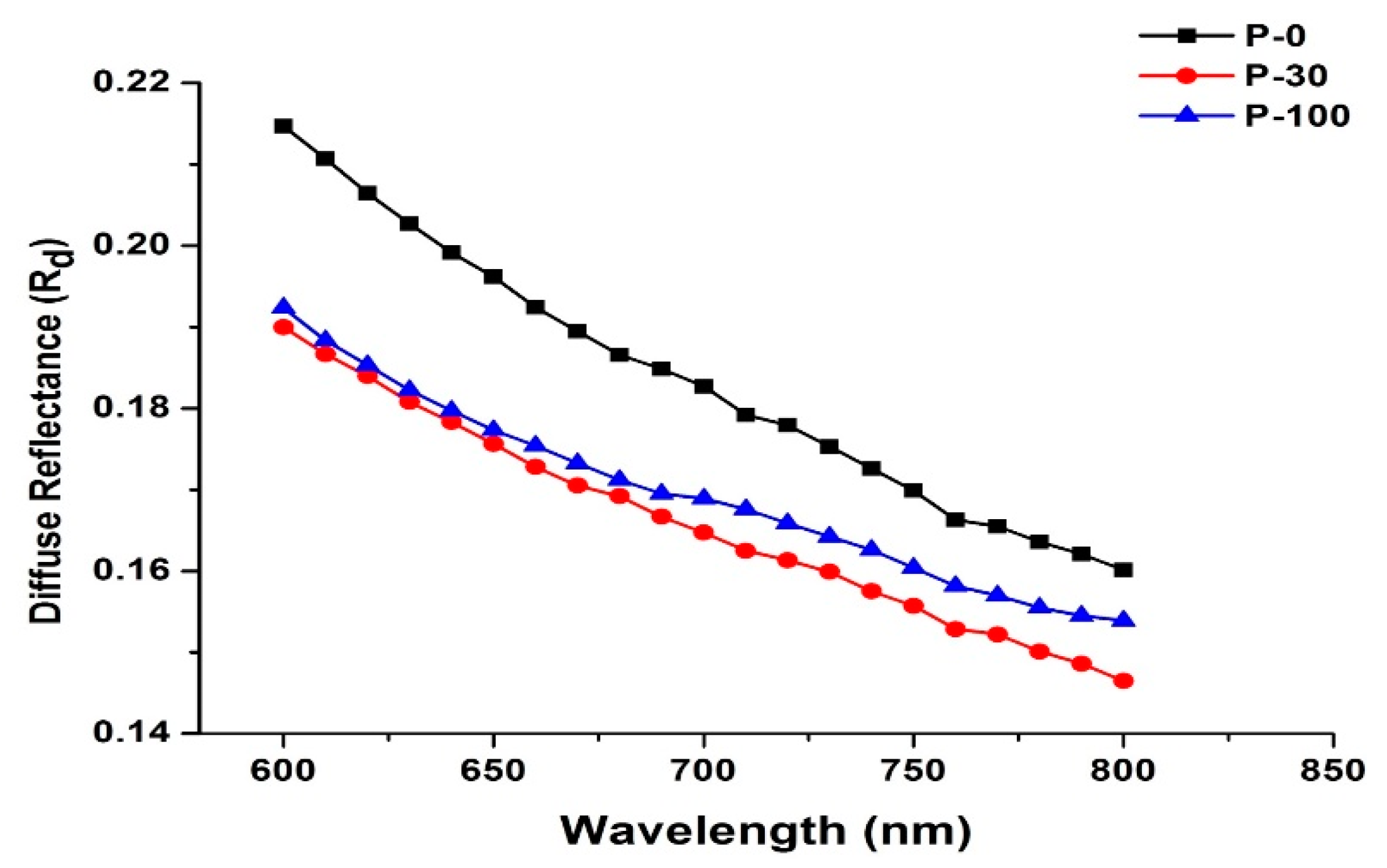
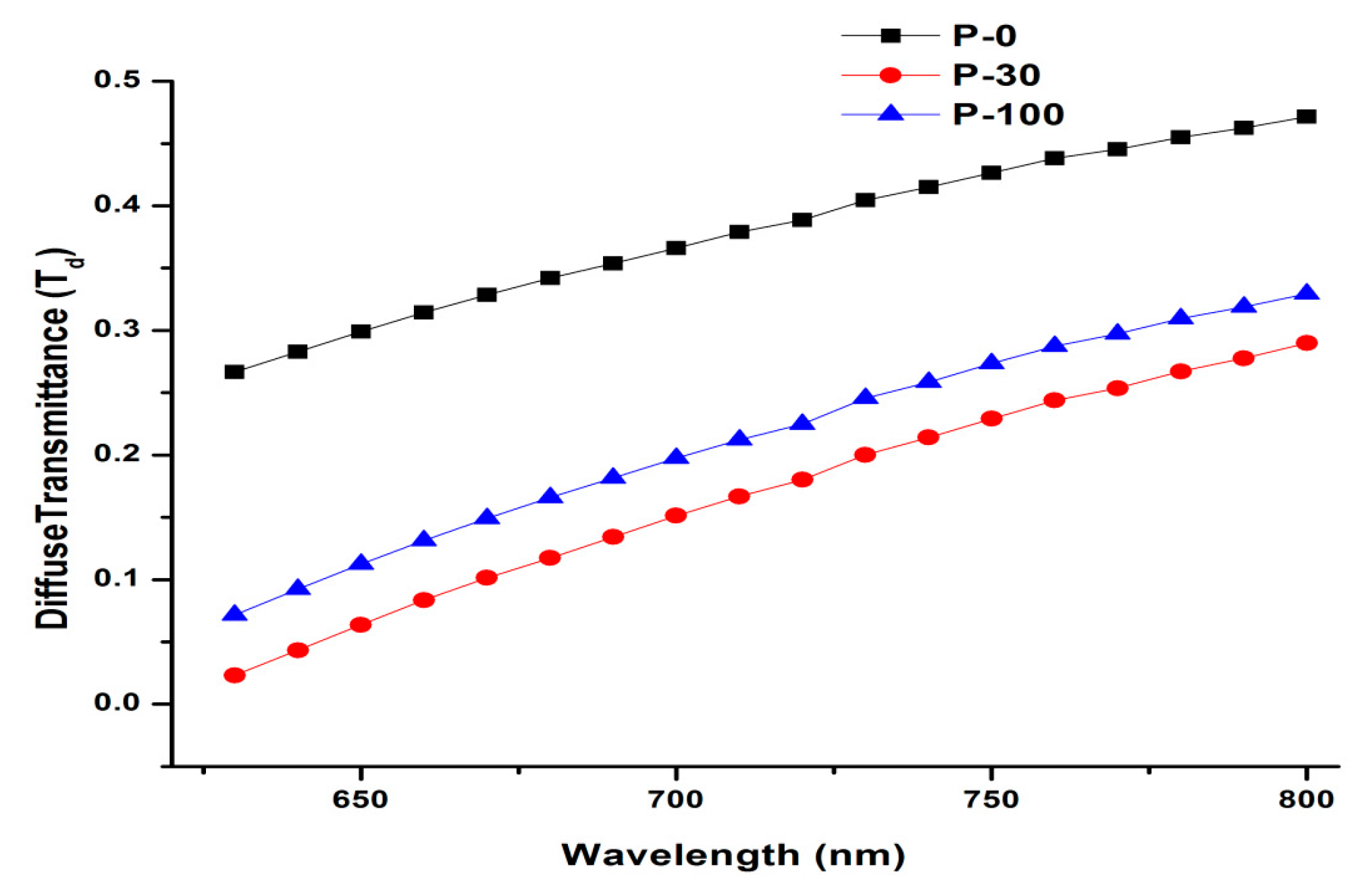
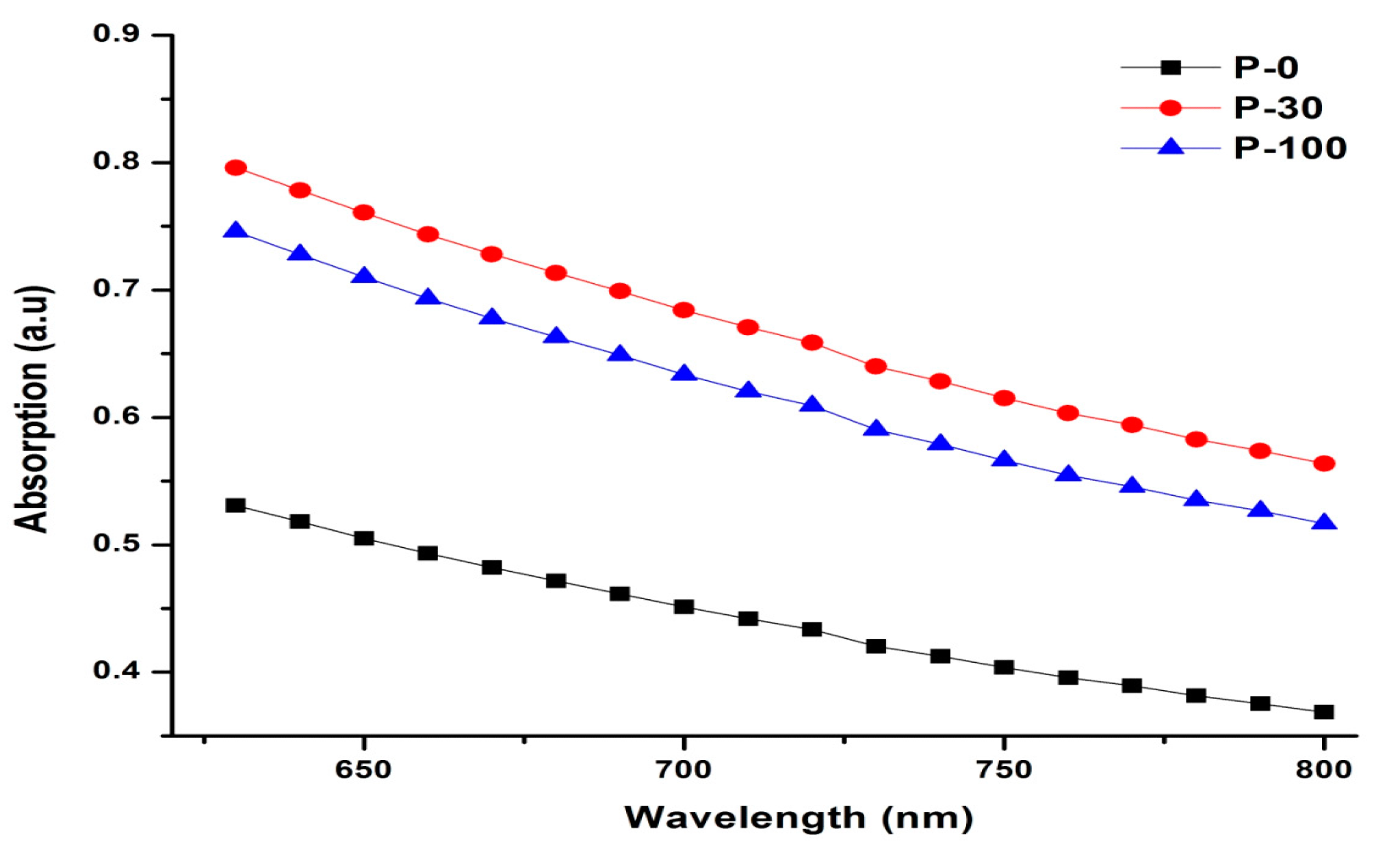
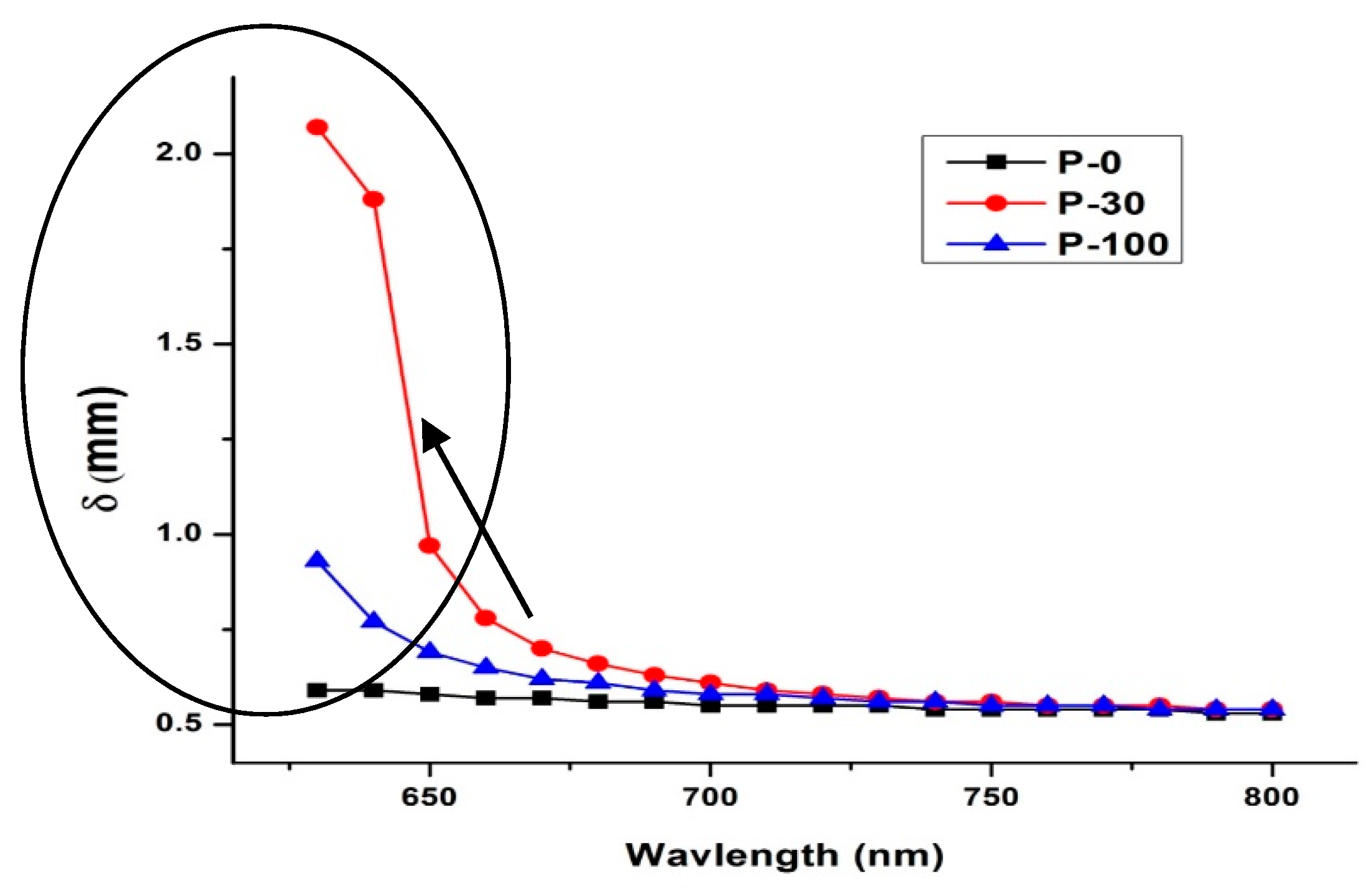
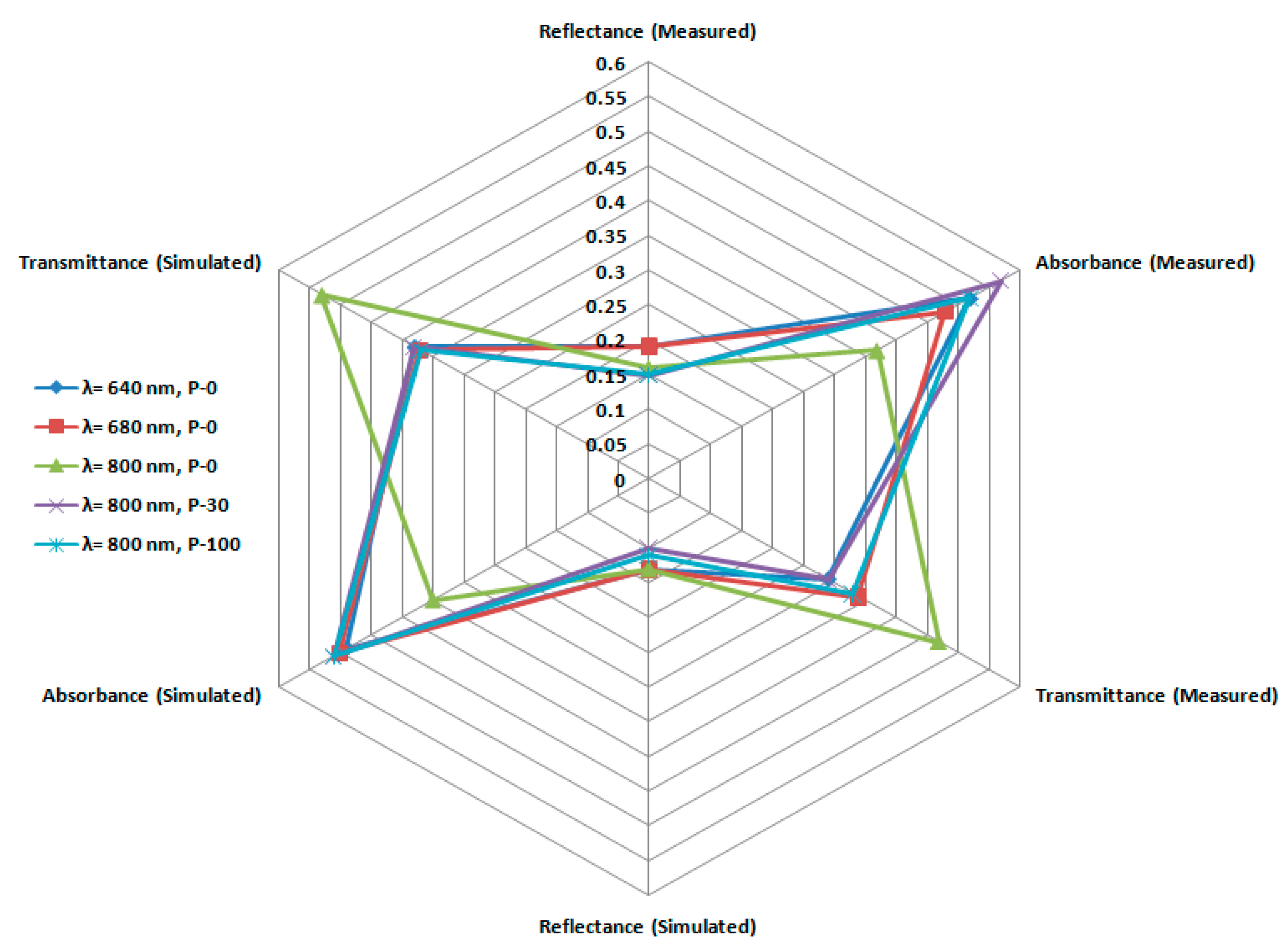
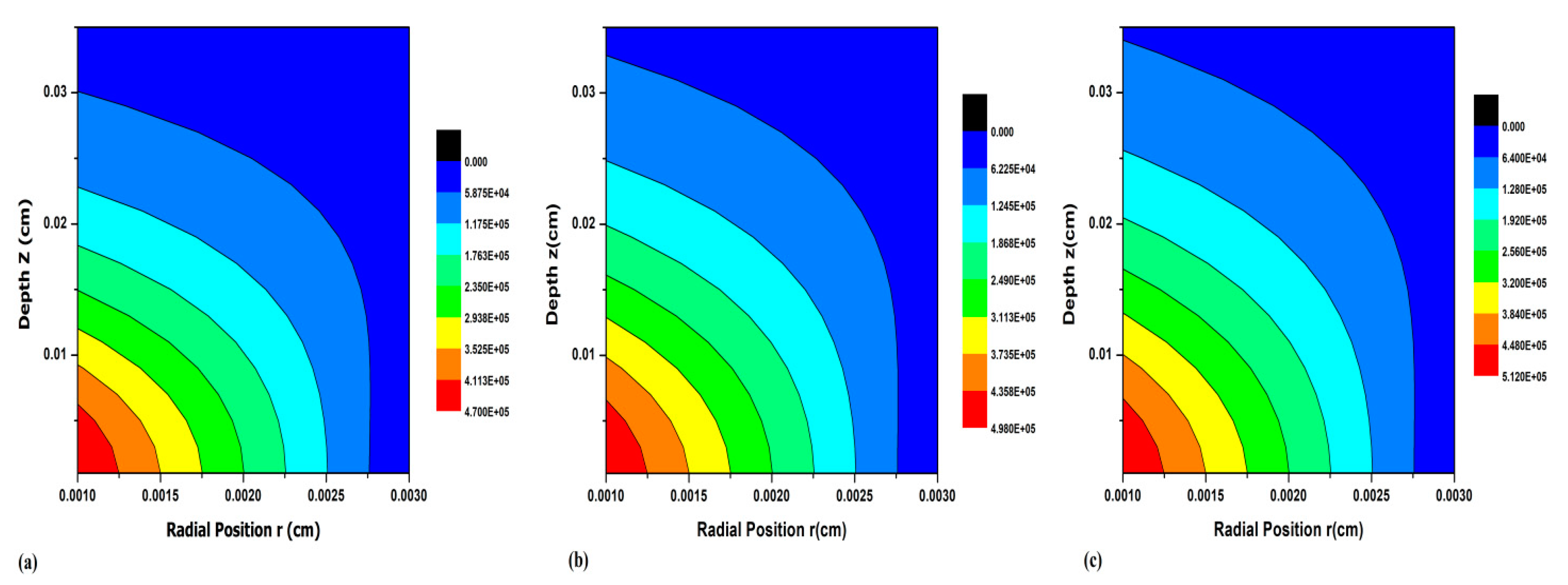
| λ (nm) | Absorption Coefficient μa (cm−1) | Scattering Coefficient μs (cm−1) | Attenuation Coefficient μt (cm−1) | ||||||
|---|---|---|---|---|---|---|---|---|---|
| P-0 | P-30 | P-100 | P-0 | P-30 | P-100 | P-0 | P-30 | P-100 | |
| 630 | 5.34 | 1.67 | 3.69 | 120.06 | 29.72 | 66.35 | 125.39 | 31.39 | 70.04 |
| 640 | 5.44 | 1.84 | 4.48 | 121.17 | 32.28 | 79.63 | 126.61 | 34.12 | 84.11 |
| 650 | 5.53 | 3.59 | 4.98 | 122.29 | 61.83 | 87.58 | 127.82 | 65.43 | 92.57 |
| 660 | 5.62 | 4.50 | 5.30 | 122.92 | 76.30 | 92.61 | 128.54 | 80.81 | 97.92 |
| 670 | 5.68 | 5.01 | 5.54 | 123.54 | 83.97 | 96.01 | 129.22 | 88.99 | 101.55 |
| 680 | 5.74 | 5.32 | 5.73 | 124.04 | 88.71 | 98.45 | 129.79 | 94.03 | 104.18 |
| 690 | 5.77 | 5.60 | 5.86 | 124.78 | 92.26 | 100.30 | 130.55 | 97.86 | 106.16 |
| 700 | 5.80 | 5.80 | 5.95 | 125.38 | 94.93 | 102.11 | 131.19 | 100.74 | 108.07 |
| 710 | 5.87 | 5.97 | 6.03 | 125.42 | 96.73 | 103.41 | 131.29 | 102.70 | 109.45 |
| 720 | 5.88 | 6.07 | 6.11 | 126.03 | 98.11 | 104.23 | 131.91 | 104.18 | 110.34 |
| 730 | 5.91 | 6.18 | 6.19 | 126.84 | 99.92 | 105.72 | 132.75 | 106.11 | 111.92 |
| 740 | 5.95 | 6.29 | 6.25 | 126.85 | 100.57 | 106.35 | 132.81 | 106.86 | 112.60 |
| 750 | 5.99 | 6.37 | 6.32 | 127.01 | 101.36 | 106.89 | 133.00 | 107.73 | 113.21 |
| 760 | 6.04 | 6.46 | 6.38 | 126.73 | 101.62 | 107.24 | 132.77 | 108.09 | 113.63 |
| 770 | 6.04 | 6.49 | 6.41 | 127.27 | 102.19 | 107.65 | 133.32 | 108.68 | 114.06 |
| 780 | 6.06 | 6.55 | 6.44 | 127.60 | 102.48 | 108.08 | 133.66 | 109.038 | 114.53 |
| 790 | 6.07 | 6.59 | 6.46 | 127.86 | 102.71 | 108.47 | 133.94 | 109.31 | 114.94 |
| 800 | 6.09 | 6.65 | 6.47 | 128.02 | 102.78 | 109.11 | 134.12 | 109.43 | 115.59 |
Publisher’s Note: MDPI stays neutral with regard to jurisdictional claims in published maps and institutional affiliations. |
© 2021 by the authors. Licensee MDPI, Basel, Switzerland. This article is an open access article distributed under the terms and conditions of the Creative Commons Attribution (CC BY) license (https://creativecommons.org/licenses/by/4.0/).
Share and Cite
Rizwan, A.; Saleem, M.; Serbaya, S.H.; Alsulami, H.; Ghazal, A.; Mehmood, M.S. Simulation of Light Distribution in Gamma Irradiated UHMWPE Using Monte Carlo Model for Light (MCML) Transport in Turbid Media: Analysis for Industrial Scale Biomaterial Modifications. Polymers 2021, 13, 3039. https://doi.org/10.3390/polym13183039
Rizwan A, Saleem M, Serbaya SH, Alsulami H, Ghazal A, Mehmood MS. Simulation of Light Distribution in Gamma Irradiated UHMWPE Using Monte Carlo Model for Light (MCML) Transport in Turbid Media: Analysis for Industrial Scale Biomaterial Modifications. Polymers. 2021; 13(18):3039. https://doi.org/10.3390/polym13183039
Chicago/Turabian StyleRizwan, Ali, Muhammad Saleem, Suhail H. Serbaya, Hemaid Alsulami, Aqsa Ghazal, and Malik Sajjad Mehmood. 2021. "Simulation of Light Distribution in Gamma Irradiated UHMWPE Using Monte Carlo Model for Light (MCML) Transport in Turbid Media: Analysis for Industrial Scale Biomaterial Modifications" Polymers 13, no. 18: 3039. https://doi.org/10.3390/polym13183039






